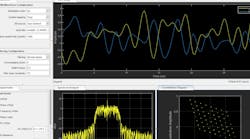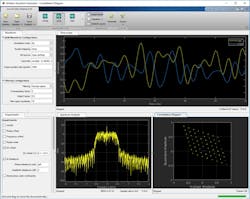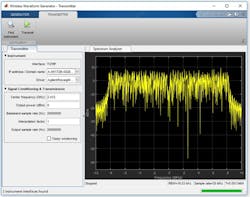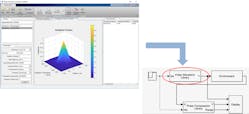We participated in the IEEE Radar Conference in Boston, Mass. in April, and it was exciting to see so many applications in which multifunctional phased-array systems support both communications and radar waveforms from the same platform. We also received many questions regarding waveform design and generation. Hence, that’s the topic of our next blog.
Let’s begin with waveform generation for wireless systems and conclude with radar waveforms. The focus of the workflow is to design waveforms that can be used for analysis work, system modeling, and connecting to test equipment.
Wireless Waveform Generation
As outlined in our blog on 5G NR waveforms, it’s straightforward to generate standard-compliant waveforms directly in MATLAB.
We also recently added a Wireless Waveform Generator app, which can be used to interactively create wireless waveforms. It includes many useful visualizations that provide insights into the signals to ensure the waveform is designed as intended. One can also filter the waveforms and add impairments directly in the app. Figure 1 shows a screenshot of the app.
1. This is the Wireless Waveform Generator app.
From the app, users can select the desired waveform type along with the corresponding parameters. Impairments can also be included. For example, it’s easy to set parameters like AWGN, phase offset, frequency offset, phase noise, dc offset, and I/Q imbalance.
The app can be used to generate communications waveforms like OFDM, QAM, and PSK. It also supports standards-compliant waveforms. For example, it’s possible to directly generate these WLAN waveforms:
- 802.11a/b/g/j/p
- 802.11n
- 802.11ac
- 802.11ad
- 802.11ah
Similarly, for LTE, users can generate:
- Downlink and uplink RMC
- Test Models (E-TM)
The waveform can be exported to the MATLAB workspace or to a file. The generated waveform is able to drive test equipment (Fig. 2).
2. Users can connect to test equipment for waveform generation.
Everything that’s done in the app can also be done programmatically from a MATLAB script.
Radar Waveform Analysis
A similar app exists for radar waveform analysis and waveform library generation.
In a radar system, the choice of a radar waveform plays an important role in enabling the system to separate two targets that are closely located in either range or speed. It’s common to examine a waveform and understand its resolution and ambiguity in both the range and speed domains. In radar, range is measured using the delay and speed is measured using the Doppler shift.
In addition, to improve the signal-to-noise ratio (SNR), today’s radar systems often employ a matched filter in the receiver chain. The ambiguity function of a waveform represents exactly the output of the matched filter when the specified waveform is used as the filter input. This exact representation makes the ambiguity function a popular tool for designing and analyzing waveforms.
Such an approach provides the insight of the resolution capability in both the delay and Doppler domains for a given waveform. Based on this analysis, one can determine whether a waveform is suitable for a particular application.
The Radar Waveform Analyzer handles this type of analysis work (Fig. 3). Using this app, one can interactively design waveforms like LFM, FMCW, Barker, and rectangular.
3. It’s possible to interactively design waveforms with the Radar Waveform Analyzer app.
Many common visualizations are also available from the app in time, frequency, and time-frequency. Users can also generate ambiguity plots directly in the app.
With the rise of multifunctional phased-array systems, it’s common for systems to implement waveform libraries. To help generate waveform libraries, waveforms can be added directly in the app. When the library is complete, it may be exported for use in a system model in MATLAB or Simulink (Fig. 4).
4. One can use the Radar Waveform Analyzer app to generate a waveform library.
With the waveform library, any model generated can implement waveform PRF and frequency agility.
Summary
Waveform design is a critical step in wireless and radar system design. Waveform building blocks exist to get started. Apps often make it easier to interactively design and analyze waveforms. These designs can be exported to help in system modeling, simulation, and connecting to hardware.
To learn more about the topics covered in this blog, see the links below or email me at [email protected].
- Using Wireless Waveform Generator App (example): Learn how to use the app as an interactive tool for creating, impairing, visualizing, and exporting modulated waveforms.
- Using Radar Waveform Analyzer App (example): Learn how to explore important properties of a signal such as its waveform, spectrum, and ambiguity function.
- Waveform Design to Improve Radar Performance (example): Learn how waveform type affects radar detection performance.
See additional 5G, radar, and EW resources, including those referenced in previous blog posts.





